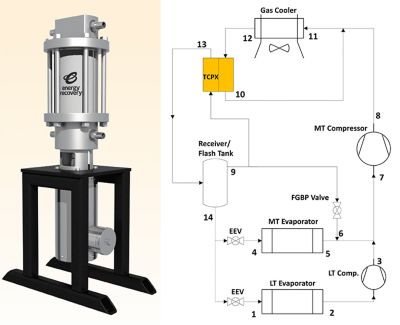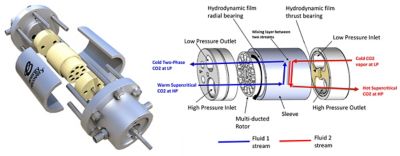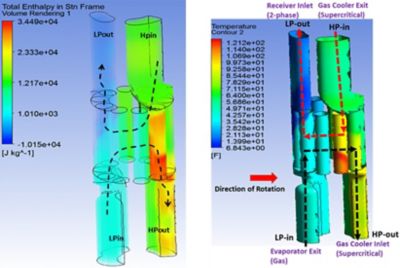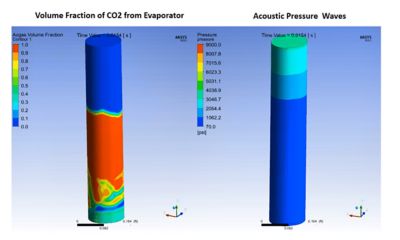-
United States -
United Kingdom -
India -
France -
Deutschland -
Italia -
日本 -
대한민국 -
中国 -
台灣
-
Ansys는 학생들에게 시뮬레이션 엔지니어링 소프트웨어를 무료로 제공함으로써 오늘날의 학생들의 성장을 지속적으로 지원하고 있습니다.
-
Ansys는 학생들에게 시뮬레이션 엔지니어링 소프트웨어를 무료로 제공함으로써 오늘날의 학생들의 성장을 지속적으로 지원하고 있습니다.
-
Ansys는 학생들에게 시뮬레이션 엔지니어링 소프트웨어를 무료로 제공함으로써 오늘날의 학생들의 성장을 지속적으로 지원하고 있습니다.
ANSYS BLOG
August 16, 2023
Keep Refrigerators Cool With Less Global Warming
To make CO2 alternatives more affordable and efficient in all climates, Energy Recovery, Inc. (ERII) designed a new technology that it says democratizes CO2 refrigeration. By integrating its own physics into Ansys’ open simulation ecosystem to extensively model and analyze complex fluid flows, structural mechanics, and heat transfer, ERII developed the first-of-its-kind transcritical rotary pressure exchanger built exclusively for CO2 systems. It recovers the expansion energy in the refrigeration system that would have otherwise been lost. This development is said to drastically reduce energy consumption and operational costs. ERII says the PX G1300 (PXG) provides energy-saving solutions for high-pressure CO2 systems that contribute less to global warming than traditional refrigeration systems. The rotary gas pressure exchanger can be used in commercial and industrial refrigeration and cold storage, and in the future could be used for data center cooling, heat pumps, geothermal power generation, and renewable energy storage.

Figure 1. Energy Recovery, Inc. (ERII) developed the PX G1300, a unique rotary gas pressure exchanger, to enable energy-saving solutions for high-pressure, transcritical carbon dioxide (CO2) refrigeration systems.
Transforming Refrigeration with CO2 Pressure Exchange
Since 1992, ERII has developed pressure exchangers that drastically reduce energy consumption and the operational costs of seawater reverse osmosis (SWRO), a process for water desalination. Expanding upon this area, ERII used multiphysics simulation to develop a pressure exchanger specifically for CO2 refrigeration systems that it says solves the key challenge associated with low-global-warming CO2 refrigeration and makes it a viable solution for a large part of the world.
The PXG is a rotary gas pressure exchanger for direct-contact, gas-to-gas, liquid-to-gas, and supercritical-fluid-to-gas pressure exchange that is designed to significantly improve energy efficiency, which is defined by the coefficient of performance (COP). Additionally, the PXG provides both expansion and compression. ERII says the PXG recovers more than 95% of lost pressure energy in both subcritical and transcritical CO2 refrigeration systems, i.e., systems that operate below and above the critical point of CO2, respectively. The compressor discharge pressure is lower than the critical pressure in subcritical CO2 systems, meaning the refrigerant can be condensed after rejecting heat to the ambient environment. Conversely, in transcritical systems, the compressor discharge pressure is greater than the critical pressure of CO2 and there is no phase change in such a supercritical state. For this reason, the refrigerant CO2 does not condense into liquid after rejecting heat to the ambient air. The PX G1300 seamlessly integrates with either system.

Figure 2. The PX G1300 rotary gas pressure exchanger functions as both a compressor and an expansion device, so it can significantly reduce energy consumption and operational costs in CO2 refrigeration systems. The pressure exchange within the PX G1300 device completes in six main steps during one complete rotation then repeats in a continous process throusands of times a minute.
The PXG is the brainchild of Azam Thatte, Ph.D., the Chief Scientist at Energy Recovery, Inc., who was previously a research scholar at the Massachusetts Institute of Technology (MIT). Thatte first conceived and published the idea of achieving transcritical compression using expansion work recovery in a rotary gas pressure exchanger. Using first principles of thermodynamics and gas dynamics, he proposed that such a compression could be achieved without using any external mechanical or electrical energy. He suggested, instead, that the compression could be achieved through acoustic waves generated during direct-contact, fluid-to-fluid pressure exchange between the high-pressure supercritical state of fluid and the low-pressure gaseous state inside a rotary pressure exchanger. However, to prove this hypothesis, he needed to build high-fidelity, multiscale, multiphysics models to study the intricate physics of this challenging problem. Further, he needed to couple the 3D macroscale gas dynamics, species and thermal transport, and wave propagation with 2D microscale, thin-film fluid physics — which also have extremely fine spatiotemporal resolution — to capture the ultra-fast timescales and geometrical nuances of the problem.
This is when Thatte shifted ERII’s research and development process from an empirical-research focus to a multiphysics-prediction-assisted methodology using Ansys’ simulation software.
Combined with his own set of partial differential equations, the computational fluid dynamics (CFD) capabilities within Ansys CFX enabled Thatte to explore the nonequilibrium thermodynamics that occur in the supercritical state of matter. In addition, he observed the interaction between multiple phases of fluid (gas, liquid, liquid–gas mixture, and supercritical state of CO2), fluid‒structure interaction, thermal transport, and species transport, which all happen simultaneously inside the transcritical rotary pressure exchanger. Furthermore, he captured large variations in length scales from microscale to macroscale and timescales from microseconds to a few hundred seconds. This exploration and research led to the development of the PX G1300 technology.
The compression of low-pressure gas (Fluid 1 in Figure 2) achieved in PXG is “free compression,” which does not consume any external mechanical or electrical energy, unlike traditional compressors. It is purely facilitated by the enthalpy extracted during the expansion of high-pressure fluid (Fluid 2 in Figure 2). According to Thatte, PXG can compress up to 30% of the total refrigerant mass flow using this free compression and therefore reduces energy consumption of the system by up to 30%. Additionally, because enthalpy is extracted during the expansion process inside PXG, it produces more liquid than the liquid produced during isenthalpic expansion across the expansion valve of a traditional refrigeration system. Also, because it is this cold liquid that produces refrigeration, additional cold liquid produced by PXG per unit mass flow further reduces energy consumption of the system.

Figure 3. This Ansys CFX simulation illustrates the “free compression” achieved through acoustic waves generated during direct-contact, fluid-to-fluid pressure exchange within PXG (left) and the temperature distribution (right).
Proving Core Physics and PXG Technology with Simulation
Within the PXG, a multiducted rotor spins at very high speed, enabling a continuous and simultaneous compression and expansion through acoustic waves generated during pressure exchange between high- pressure, supercritical CO2 and low-pressure, gaseous CO2. Compression and expansion waves propagate back and forth at the speed of sound through the ducts — a discovery Thatte made and proved through coupled-physics simulations and analyses.
“Nobody was willing to believe this hypothesis because it was such a radical idea of using a supercritical state of matter to compress low-pressure gas through acoustic waves generated during direct-contact, fluid-to-fluid pressure exchange,” he says. “People could not believe it until I showed them the high-fidelity 3D Ansys simulation and explained to them that this is actually solving three-dimensional Navier-Stokes equations, the thermal transport, species transport, and phase change all at once.”

Figure 4: An experimental setup was built to validate the predictions of PXG physics and the energy savings. On the left: the high-pressure gas cooler with supercritical CO2. On the right: the low-pressure evaporator and receiver with two-phase and gaseous CO2.
Traditionally, a reciprocating compressor has a piston that compresses the gas, trapping it between a stationary wall and a moving piston; that’s how the pressure is increased. On the other hand, a centrifugal compressor has blades that spin at high speed and convert kinetic energy into pressure energy. The PXG uses acoustic waves to create almost instantaneous pressure exchange at the speed of sound, eliminating in the process the energy loss that typically occurs with traditional technologies, says Thatte. Its name, PX G1300, is a nod to the first milestone pressure reached during its earliest demonstrations at 1,300 psi.
“Once I showed the coupled-physics CFD results, people slowly gained confidence in this concept and our board approved funds to build the first prototype and experimental setup to prove the concept experimentally,” explains Thatte. “Ansys simulations enabled us to build high-fidelity models that played a very crucial role in investigating the multiphysics interactions that happen inside the rotor of the pressure exchanger and to validate the initial concept.”
Figure 4 shows the experimental setup that Thatte built to validate PXG’s transcritical CO2 compression-expansion physics and its energy savings in the CO2 refrigeration system. By integrating PX G1300 into a CO2 refrigeration system, ERII says it has demonstrated experimentally up to 30% improvement in COP for warmer climates and more than 20% COP improvement for relatively cooler climates.
In addition to the fluids analyses, Thatte evaluated the structural integrity of the device using Ansys Mechanical. Through thermal analyses, Thatte ensured that the PXG’s rotor ducts could withstand high-temperature thermal stresses and that the thermal expansion would not excessively close the microscale, hydrodynamic bearing clearances between rotor and stator. He also confirmed that its gas-film bearing stiffness would prevent the contact between the rotor and stator, allowing the rotor to spin freely during the pressure exchange process.
Thermal analyses also helped ERII select and validate the ceramic core material of the device, together with Ansys Granta MI Enterprise materials data management software. Within Granta, Thatte explored a wide variety of materials and their thermophysical properties. Additionally, Ansys high-performance computing (HPC) solutions enabled Thatte to run complex, computationally intensive simulations on a supercomputing cluster that he has designed and built at ERII. Thatte also credits the support from Ansys Elite Channel Partner Ozen Engineering, Inc. in navigating the complexities associated with running such coupled physics models on supercomputing clusters.
Thatte says Ansys simulation tools significantly accelerated the timeline from initial discovery and concept exploration to technology maturation and product commercialization.

Figure 5. ERII engineers studied high-speed acoustic pressure exchange inside PXG using Ansys CFX to improve the efficiency of CO2 refrigeration.
“Design methodologies are not only to understand what’s happening at the fundamental scientific level, but also to mature the technology from the ideation and conceptualization stage all the way to commercialization in a very fast-paced manner,” he says. “Ansys was very helpful from the early conceptualization stage of the PXG. From when I first came up with the idea to actually installing this product in a commercial setting in an Italian supermarket — and saving close to 30% energy for that customer — all happened within a span of just over two years, and that was in large part due to the insights I gained from the multiscale, coupled-physics Ansys simulations.”
ERII has also adopted Ansys’ tools for other applications as well. In another product line, the team uses Ansys BladeModeler to simulate and design the turbopumps.
Having successfully demonstrated energy savings provided by PXG technology, Thatte is now exploring novel applications of PXG for increasing energy efficiency of heat pumps, data center cooling, geothermal power generation, and thermal energy storage.










